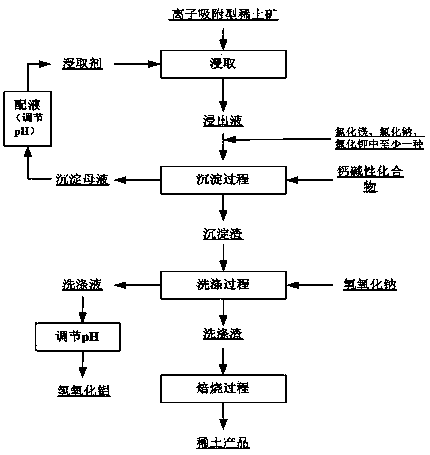A method for recovering rare earth and aluminum from ion adsorption type rare earth ore
An ion adsorption type, rare earth ore technology, applied in the field of rare earth and aluminum recovery, can solve the problems of reducing the purity of rare earth concentrate products, poor crystallization performance, and inability to obtain products, so as to facilitate the precipitation of crystal forms and avoid the loss of rare earth , The effect of improving the recovery rate
- Summary
- Abstract
- Description
- Claims
- Application Information
AI Technical Summary
Problems solved by technology
Method used
Image
Examples
Embodiment 1
[0041] Example 1: Using a magnesium-containing sulfate and chloride mixed solution (the molar ratio of sulfate and chloride is 0.5:1) to leach ion-adsorbed rare earth ores, the obtained aluminum content is 0.05g / L, and the rare earth content is 0.3g / L (calculated as REO) leach solution; add magnesium chloride to the leach solution to control the chloride ion concentration in the leach solution to 0.30mol / L. Calcium oxide is added to the leaching solution for precipitation, the precipitation temperature is 20°C, and the pH of the precipitation end point is controlled to be 8.5; then solid-liquid separation is carried out, and the precipitation mother liquor and precipitation residue are obtained after washing with water. The pH of the precipitation mother liquor is adjusted to 1.5 with concentrated sulfuric acid and then directly returned for leaching. The precipitated slag is washed with 0.3mol / L sodium hydroxide solution, and the liquid-solid ratio is controlled to be 1:0.5; ...
Embodiment 2
[0042] Example 2: Using a mixed solution of sulfate and chloride containing magnesium (the molar ratio of sulfate and chloride is 0.5:1) to leach ion-adsorption type rare earth ore, the obtained aluminum content is 0.1g / L, and the rare earth content is 0.5g / L (calculated as REO) leach solution; add magnesium chloride to the leach solution to control the chloride ion concentration in the leach solution to 0.30mol / L. Calcium hydroxide is added to the leaching solution for precipitation, the precipitation temperature is 20°C, and the pH of the precipitation end point is controlled to be 8.5; then solid-liquid separation is carried out, and the precipitation mother liquor and precipitation residue are obtained after washing with water. The precipitation mother liquor is adjusted to pH 2 with concentrated sulfuric acid and returned directly for leaching. The precipitated slag is washed with 0.3mol / L sodium hydroxide solution, and the liquid-solid ratio is controlled to be 1:0.5; th...
Embodiment 3
[0043] Example 3: Using a mixed solution of sulfate and chloride containing magnesium and potassium (the molar ratio of sulfate and chloride is 2:1) to leach ion-adsorbed rare earth ores to obtain a rare earth mineral with an aluminum content of 0.3g / L. A leach solution with a content of 2g / L (calculated as REO); add magnesium chloride and potassium chloride to the leach solution, and control the chloride ion concentration in the leach solution to 0.40mol / L. Calcium oxide is added to the leaching solution for precipitation, the precipitation temperature is 40°C, and the pH of the precipitation end point is controlled to be 8.8; then solid-liquid separation is carried out, and the precipitation mother liquor and precipitation residue are obtained after washing with water. The precipitation mother liquor is adjusted to pH 2 with concentrated sulfuric acid and returned directly for leaching. The precipitated slag is washed with 0.5mol / L sodium hydroxide solution, and the liquid-s...
PUM
 Login to View More
Login to View More Abstract
Description
Claims
Application Information
 Login to View More
Login to View More - R&D
- Intellectual Property
- Life Sciences
- Materials
- Tech Scout
- Unparalleled Data Quality
- Higher Quality Content
- 60% Fewer Hallucinations
Browse by: Latest US Patents, China's latest patents, Technical Efficacy Thesaurus, Application Domain, Technology Topic, Popular Technical Reports.
© 2025 PatSnap. All rights reserved.Legal|Privacy policy|Modern Slavery Act Transparency Statement|Sitemap|About US| Contact US: help@patsnap.com

